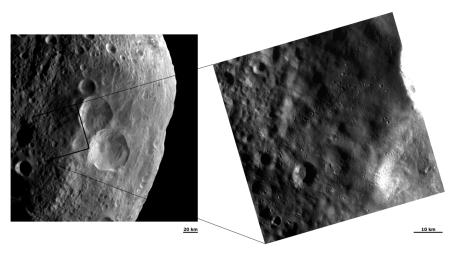
|
Ejecta Blanket
- Click the image above for a larger view
- Full-Res JPEG (2500 x 1400) (304.8 kB)
- Full-Res TIFF (2500 x 1400) (3.5 MB)
Caption:
These Dawn FC (framing camera) images show two different resolution views of the ejecta blanket of Vesta's "snowman craters." The snowman-like pattern of these craters is clearly seen in the center of the left hand image. However, the ejecta blanket surrounding these craters is much less obvious in the lower resolution, left hand image. The ejecta blanket is much clearer in the higher resolution right hand image: it is visible as an area of Vesta's surface which is significantly smoother than the neighboring regions. The ejecta blanket thins towards the top left of this image and consequently Vesta's surface begins to appear rougher. Some older impacts are seen through the ejecta blanket and the clusters of small, fresh craters on the ejecta blanket are likely secondary impacts. These secondary craters probably formed due to large debris being thrown out of the "snowmen craters" during their formation. The smaller debris which were thrown out formed the ejecta blanket.
NASA's Dawn spacecraft obtained these images with its framing camera on August 20th and September 20th 2011. These images were taken through the camera's clear filter. The distance to the surface of Vesta is 2740 km and 673 km and the images have a resolution of about 260 meters and 66 meters per pixel respectively.
Background Info:
The Dawn mission to Vesta and Ceres is managed by NASA's Jet Propulsion Laboratory, a division of the California Institute of Technology in Pasadena, for NASA's Science Mission Directorate, Washington D.C. UCLA is responsible for overall Dawn mission science. The Dawn framing cameras have been developed and built under the leadership of the Max Planck Institute for Solar System Research, Katlenburg-Lindau, Germany, with significant contributions by DLR German Aerospace Center, Institute of Planetary Research, Berlin, and in coordination with the Institute of Computer and Communication Network Engineering, Braunschweig. The Framing Camera project is funded by the Max Planck Society, DLR, and NASA/JPL.
More information about Dawn is online at http://www.nasa.gov/dawn and http://dawn.jpl.nasa.gov .
Cataloging Keywords:
| Name | Value | Additional Values |
|---|---|---|
| Target | 4 Vesta | |
| System | Main Belt | |
| Target Type | Asteroid | |
| Mission | Dawn | |
| Instrument Host | Dawn | |
| Host Type | Orbiter | |
| Instrument | Framing Camera (FC) | |
| Detector | ||
| Extra Keywords | Crater, Grayscale, Impact | |
| Acquisition Date | ||
| Release Date | 2011-10-19 | |
| Date in Caption | ||
| Image Credit | NASA/JPL-Caltech/UCLA/MPS/DLR/IDA | |
| Source | photojournal.jpl.nasa.gov/catalog/PIA14958 | |
| Identifier | PIA14958 | |
